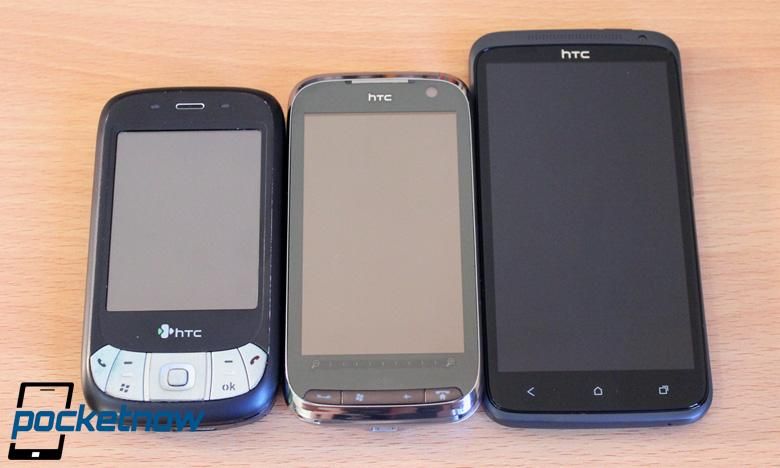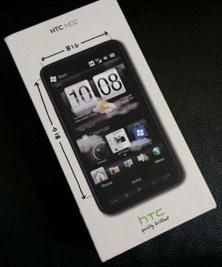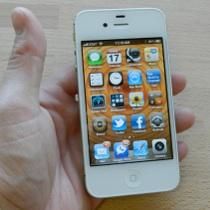There was a time when Nokia ruled the world and everybody tried to follow. Where soft keys were the order of the day, again another Nokia UI invention, and where competitors like Microsoft tried to follow with Windows Mobile 5. A time where large 3.5-inch Pocket PCs begun shrinking into the 2-inch form factor in order to adopt the then new smartphone revolution. That was a time when one-handed usability was the standard and you could choose whether to operate your smartphone with navigation keys or your stylus. Times that even included smaller screens to fit front-facing QWERTY keyboards, track wheels and even track balls in order to compete with king #2 BlackBerry. Back then, the smaller it was, the sexier it was, but boy have things changed.
The iPhone and the HTC HD2 sprung a new revolution. People bash the iPhone for how small it is today, but back in 2007 it was huge if you compared the screen to the flagship HTC TyTN II of the day. Sexy shifted from small and navigation-friendly to thin and large. The HTC HD2 today means a lot more than simply the Windows Phone that's still capable of running every Android iteration that has been released. It begun something we never thought would be so important for today's standards of what a flagship smartphone should be. Its box, which is still something I remembered as iconic, spelled it well: It was big.
"Phonezillas" are now recognized as the best phones. You can tell the difference between the best Samsung phone and the cheapest one simply by comparing their sizes. The standard began at 4-inches, grew to 4.3 and is now between the 4.7 or 4.8-inch mark. Anything bigger than that is now known by a different name, but is still considered top-notch. The larger they get, the thinner they become and then some are even fit with curved designs all around so that you don't feel them as bulky when you handle them. Again, times have changed.
This new trend has a lot of advantages and disadvantages. Watching a video or playing a game on a large phone is far better than trying to do it on a small device. The problem with the trend is that people that value a powerful and fluid experience are now forced to adopt a large smartphone even if they don't want to. Half the people I know are just after a very fast phone, with top-of-the-notch specs and the best screen in the market, but they end-up buying an iPhone simply because a Galaxy S III is just too large for the one-handed usability that their busy lifestyle also demands. There are different types of power users today, and since I have a hard time choosing a solution for my needs, I decided to go for an HTC One X and an iPhone 4S as my daily drivers, so that I'm able to use the best of both worlds to solve my daily tasks. If you're still having a hard time deciding whether a large phone serves your needs or not, we'll try to narrow the reasons why either of them matter, starting with the reasons why I don't like them.
The Cons of a big phone
Small phones are ironically better at being faster phones for day-to-day use. You pull them out of your pocket with one hand, reach the power button with that same hand, navigate to the phone app with the same hand, dial and then hold the phone to your ear with again, that same hand. It makes me remember the times when I became an expert at flipping my old Motorola StarTAC open with one hand to start a call and end it. There is a lot of psychology behind the One-hand usability paradigm, and a smaller phone that was built around that mentality will always help you be more productive if your lifestyle is busy.
Another thing that concerns me the most about this new trend of "phonezillas", is that it sometimes feels like if every OEM is in a rush to get a larger phone into the market in order to compete with another, but not every OEM is actually testing the whole experience before they release their product. There are devices that do a great job at being bigger all around, and then there are others that make you feel like if the people that were in charge of designing the phone, never paid a visit to the guys that were designing the UI. For example, if you buy a Galaxy Nexus, you'll notice that Android was very well designed as a large-phone UI. If you try to send somebody an email, all the control buttons that you'll need to start working on your email are at the bottom. Try doing the same with the Galaxy S III or HTC One X and behold your frustration as you try to reach some of those same buttons at the top while on the go. Some OEMs think that the user interface is limited to what's on the screen, and really the experience is dominated by the whole combination of how you'll approach the hardware as you deal with software. With a small phone, it doesn't matter if the UI guys scattered the buttons all around the screen, you'll always be able to reach them easily with one hand even while your hands are docked at the bottom for typing.
Another problem with large phones, which to me is the most ironic of all, is that thumb typing isn't really better on a huge screen. There's definitely a new ergonomics problem that lacks a name because of how new it is, but this is like the BlackBerry thumb syndrome we faced years ago. The larger a phone is, the heavier it is, and therefore the more difficult it is to hold with two hands while you're also using fingers to hold it in place. I've got big hands, and I still find some strain on my right pinky after a day of thumb-typing, simply because I need it to hold the phone in place as I try to reach all the keys on a large device like the One X. Large keys make sense when you have a hardware keyboard you can feel, but on a screen, you'll still fall into typo territory because you can't feel what you're doing. As autocorrect gets better over the years, hitting the right key keeps becoming something of the past.
Probably my biggest problem with a large phone is that they're not necessarily stronger devices. To keep them thin and light, OEMs end up using a lot of plastic, composite joints and even less screws, which later turns into a big hit in durability. That ends up forcing you to get a case to protect the device from falls, which only makes the phone bigger than it already is. Small phones also fit better in your pocket, so it's also more comfortable to carry around.
The Pros of a big phone
This is going to sound funny, but big phones exist for a reason. It actually makes sense for the most powerful specs to be pushed only into the larger phones, since this extra horsepower will only become important if you use your phone for gaming and media consumption. Playing a game or watching a movie on an iPhone is simply cumbersome, no matter what the late Steve Jobs believed. Apple would've never released a tablet if it weren’t because they reached the conclusion that content consumption on something as small as an iPhone was not optimal. Carrying around a tablet as heavy as the iPad is not optimal either.
The biggest advantage of a large phone is precisely the fact that it tries to give you one device that fits all your needs. HTC and later Samsung have both made a smart and bold move in betting their companies around a solution in the middle of a phone and a tablet. A smartphone that's thin enough to still fit in your pocket, powerful enough to give you the multimedia and gaming experience that most power users covet, and a screen that matches the resolution of most tablets in the market. Just as tablets, big phones weren't made to operate with one hand, but then again, a good portion of the market doesn't value pocket-ability as much as they value buying just one device that solves most of their needs.
Another advantage of large phones with good screen resolutions is real estate. An HTC One X is not the size of a paperback book, but you'll definitely get an experience close to it. Navigating any webpage on a small screen is just not what users want anymore. There comes a point where friends of mine complain about getting lost around a webpage when using an iPhone, and being forced to zoom in and out constantly in order to feel control over it. When watching a movie, you'll never be able to beat a real TV or even a 10-inch tablet, but none of these is easy to carry around on a subway either if you're on the go, as a large phone is. I'm an avid gamer, and getting used to playing games on a smartphone was something that took me a long time. I would buy the games and never play them on the iPhone simply because my thumbs would always cover important aspects of the game as I tried to navigate. Keeping your attention span on a small screen is also complicated if you're moving the device around as you play a game. Even from a business user's perspective, reading documents or a spreadsheet are far better on a large phone. Smartphones will definitely never substitute a tablet or a laptop when it comes to business uses like these, but it's sure great to have an extra tool that can also help you get things done while on the road.
Probably the biggest advantage of owning a large phone is that it's the only way you'll have the best of the best in your hand. As OEMs keep fighting over screen-size dominance, the only way you can be sure that you've got the best technology available for just about anything, is if you think big.
The bottom line
One size doesn't fit all, and everybody's mileage varies. Some people have small hands and can't even hold a Galaxy S III without dropping it, and some people have big hands and even then find a large phone as too big to be comfortable to use. Others don't care if their hands are big or small, or if the phone is comfortable to carry around as much as they care about content consumption everywhere they are. Netflix would've never launched a smartphone app if it wasn't because there's a large market of users that actually watch a movie on their phones, so in cases like these, size does matter.
If you're still on the ropes trying to decide what's best for you, I'd recommend you analyze your most common habits first. If you've got a busy life, rarely watch movies, read books or play games, and simply use your phone for email, communication or messaging, a large phone will only frustrate you. You're after quick and easy, and small phones are better at solving those types of needs. On the other hand, if your email account is only flooded with subscription mail, you play a lot of games or want to keep-up with your favorite TV show no matter where you are, a big phone is the way to go. It'll give you both worlds on a large package, but it won't frustrate you for the things you least care about.
I wish I knew when this trend of smartphone growth will stop though. It's becoming kind of boring to have to settle for a big phone if we want the best specs. Surely there are alternate solutions like the HTC One S where you get some good specs on a mid-sized package, but when faced with a price that's close to the One X, things get complicated.
Today it’s all about “Phonezillas”. What do you think the next trend will be? Be sure to share your thoughts in the comments down bellow.




